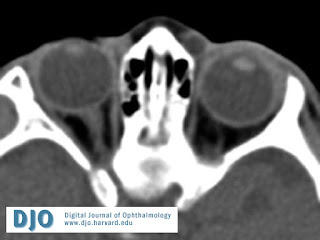 Niño de 14 meses de edad que presentó masa
orbitaria izquierda supero-nasal que ha ido aumentando de tamaño.
Niño de 14 meses de edad que presentó masa
orbitaria izquierda supero-nasal que ha ido aumentando de tamaño.
Preguntas
¿Cuál es el diagnóstico más probable?, ¿Cuál es
el diagnóstico diferencial? ¿Cuáles son las características histológicas de
esta enfermedad? ¿Describir el manejo de esta condición?
Questions and Answers
1. What is the most likely diagnosis?
Answer:
Orbital dermoid cysts are the most common mass lesions found in the pediatric
orbit, accounting for 46% of all orbital lesions and 89% of cystic lesions.
Dermoids usually present in the first decade of life, though deeper dermoids
may not become apparent until adulthood. They are frequently located near
suture lines between bones, and are most commonly found superotemporally along
the zygomaticofrontal suture. Palpation reveals a firm mass which is fixed to
the underlying bone. Rupture of the cyst can cause an intense inflammatory
response.
Answer: The
differential diagnosis includes other cystic lesions such as simple epithelial
cysts, encephalocele, mucocele, teratoma, inflammatory cysts (echinococcal,
cysticercosis), and tumors with cystic components (adenoid cystic carcinoma,
rhabdomyosarcoma, lymphangioma).
3. What are the histological features of this
condition?
Answer:
Dermoid cysts are typically encapsulated. They are lined with keratinized
stratified squamous epithelium and are filled with keratin. The presence of
dermal structures such as hair, sebaceous glands, and sweat glands in the cyst
wall differentiates dermoids from simple epithelial cysts.
Answer:
Standard treatment involves complete surgical excision. Preoperative evaluation
includes imaging with computed tompgraphy to assess for the extent of the cyst.
Some cysts are dumbbell shaped with both an extraorbital and an intraorbital
component. Rarely dermoid cysts can have intracranial
extension.
The surgical
approach depends on the location of the cyst. Care is taken to avoid cyst
rupture intraoperatively. Incomplete excision can result in recurrence.
Extremely large dermoids may require aspiration prior to excision.
Fuentes:












0 comentarios:
Publicar un comentario